Exploring the Significance of April's Birthstone: Diamonds
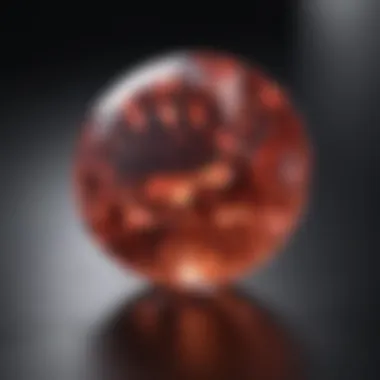
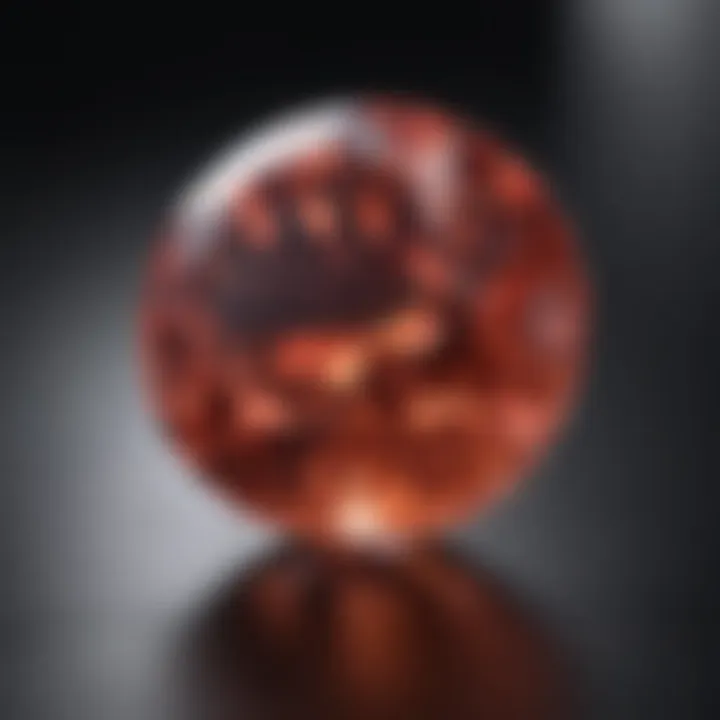
Intro
April's birthstone, the diamond, stands out not just for its brilliance, but also for its myriad of meanings and attributes. For many, diamonds signify love and strength. But there's more to them than simply being symbols of romance. This article will peel back the layers on what makes diamonds such a sought-after gemstone and explore their historical significance, unique properties, and their importance in culture and jewelry design.
Gemstone Overview
Definition and Origins
Diamonds, composed primarily of carbon atoms, are renowned for their unmatched hardness. They form deep within the Earth under extreme pressure and temperature. Interestingly, the process of diamond creation can take billions of years. Some diamonds originate from meteorite impacts, while others come from volcanic activity.
Humans have adored diamonds for centuries, with their first recorded usage dating back to India more than 2,500 years ago. Initially, they were considered talismans of good fortune and protection, serving roles far beyond mere adornment. The term ‘diamond’ derives from the Greek word ‘adamas’, which means invincible or untameable—rather fitting for such a resilient gem.
Historical Significance
Historically, diamonds have been woven into the fabric of power and mythology. The famous Koh-i-Noor diamond, once owned by Indian royalty, eventually became part of the British Crown Jewels, encapsulating centuries of history and conquest.
For ancient civilizations, diamonds were viewed as possessing mystical properties. In India, they were believed to ward off evil spirits while in Europe, they gained popularity during the Middle Ages, symbolizing purity and virtue.
"The enduring allure of diamonds is not just in their aesthetic beauty but also in the tales they carry through history."
In literature, diamonds are often depicted as symbols of unbreakable bonds—think of the phrase "a diamond is forever". This phrase articulates something more profound, a belief rooted in human emotions that diamonds have transcended generations.
Gemstone Properties
Hardness and Durability
Diamonds are graded on the Mohs scale with a score of 10, making them the hardest natural substance known to man. This durability is why they are popular choices for engagement rings and other jewelry, representing an everlasting commitment. One can look at a diamond with satisfaction, knowing it can withstand life's trials.
Color and Clarity
Though often associated with being colorless, diamonds can actually be found in an array of colors—pink, blue, and even yellow hues. These colored diamonds, often called fancy diamonds, grab attention for their uniqueness.
Clarity refers to the presence of imperfections within a diamond. Ideally, a flawless diamond is highly coveted, yet inclusions can sometimes add character, telling a story of its own, making clarity an interesting aspect to consider in evaluation.
In summary, understanding the characteristics of diamonds enhances one's appreciation for these gemstones. It’s not merely about visual beauty; it's about the entire experience, from their formation deep in the Earth to their refined end product on display in jewelry boutiques.
With diamonds hailed for their eternal nature and rich heritage, the journey of discovery reveals layers that speak to collectors and enthusiasts alike.
Foreword to April Birthstones
April is a month held in high esteem, not just for the spring blossoms that emerge after winter's retreat but also for its illustrious birthstone: the diamond. The role of the diamond in conversations about birthstones goes beyond mere aesthetics. It invites a deeper exploration into personal identity, cultural beliefs, and even emotional connections. This section aims to shed light on the multi-layered significance of April's birthstones, teasing apart the concepts, significance, and traditions rooted in this particular time of year.
While many may view birthstones as simple adornments, they hold a deeper meaning, entwined within humanity's history and personal stories. The concept of a birthstone is steeped in tradition, offering not just beauty but also a sense of belonging and connection crafted through time. This tradition is especially notable for those born in April; the diamond beckons with its allure, serving as both a personal talisman and an emissary of opulence.
The Concept of Birthstones
The notion of birthstones is far more profound than meets the eye. Centuries ago, the twelve stones associated with the twelve zodiac signs were thought to have specific powers and benefits. Each stone corresponded to particular months, believed to bestow luck, protection, and even health to those born during that month. In the case of April, the diamond symbolizes clarity, strength, and the promise of eternal love.
To many, wearing one’s birthstone is an ageless custom. It’s not just about vanity; it’s about the stories the stones carry. When someone opts for a diamond, they often embrace traits tied to this formidable gem—unwavering resolve, a sense of prestige, and an eternal bond, be it in relationships or personal ambitions. Interestingly, as people learn about the lore tied to their birthstones, they often find a refreshing connection to who they are as individuals, which is a thrilling aspect of how personal adornment intertwines with identity.
The Significance of April 14th
April 14th stands as a unique date within the broader context of the month. Those born on this day are seen as possessing particularly refined tastes and a striking charisma, often drawn towards the luxurious. The diamond, as their birthstone, resonates well with their character. It embodies more than just physical beauty; it symbolizes an innate strength and unwavering determination that April 14th individuals often exude.
In terms of cultural perspective, this day is often associated with renewal, much like spring itself. New beginnings imbue the energy surrounding this date, transforming it into a symbol of hope and potential. Thus, those born on April 14th not only celebrate their birthday but also the hope that comes forth with the arrival of spring.
"Diamonds are forever, just like the promise of fresh starts each spring, particularly for those born under April's captivating charms."
In summary, understanding the significance of April's birthstones—especially diamonds—opens the door to exploring both personal and collective histories. Each individual’s relationship with their birthstone is layered, rich with stories waiting to be told. This section sets the stage for diving deeper into diamonds, revealing their many facets and introducing readers to what makes this gemstone truly remarkable.
Diamond: The Birthstone for April
Diamonds, often regarded as the most prized gemstones, hold a significant position as the birthstone for the month of April. Their enduring allure is not just in their aesthetic beauty; they symbolize a deep connection to strength, endurance, and luxury. This article aims to delve into the distinctive characteristics of diamonds, their historical context, and the factors that make them a favored choice for jewelry, especially for those born on April 14th.
Characteristics of Diamonds
Color Variations
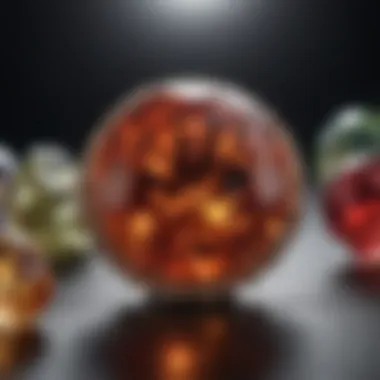
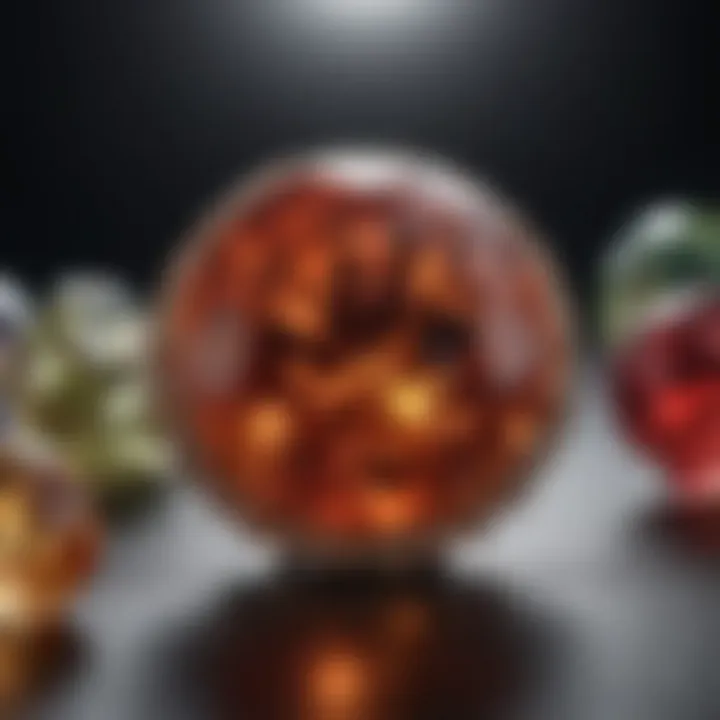
Color variations in diamonds can range from the classic white to fancy colors such as blue, pink, and even green. Each color tells its own story, giving wearers a chance to express themselves through their gemstone choice. For example, blue diamonds, with their captivating hue, signify serenity and peace, often catching the eye of collectors and individuals looking for unique pieces.
The key characteristic of diamonds is the way light interacts with them. Pure diamonds are colorless, but the inclusion of certain elements during their formation can lead to stunning colors—sapphire blue and rose pink being among the most popular. This unique aspect of color variation is what makes diamonds an exceptional choice; they reflect individuality and personal style in ways that other stones might not. However, it's crucial to be aware that while color can add value, colors of lesser quality can also occur and may not demand the premium pricing associated with high-grade colored diamonds.
Clarity and Cut
Clarity and cut significantly impact a diamond's brilliance. Clarity refers to the presence of internal or external imperfections. Higher clarity diamonds are more sought after, as they offer a clearer view of the stone's natural beauty. The cut is equally important; it determines how well a diamond interacts with light. A well-cut diamond can dazzle, reflecting light in a way that a poorly cut one never could.
The key characteristic of clarity also ties into the perception of quality. The Gemological Institute of America features a grading system that ranges from Flawless to Included. Buyers often favor diamonds with fewer inclusions for engagement rings or significant gifts. However, some might appreciate a unique character presented by naturally occurring imperfections.
Carat Weight
Carat weight is often the first thing people think of when considering diamonds. It indicates the size of the diamond, yet it’s not the only determinant of a stone's value. There’s a common misconception that larger is always better. While a stunning one-carat stone can turn heads, many smaller stones can exhibit far superior quality when clarity and cut are factored in.
The key characteristic of carat weight is its straightforwardness. It provides a tangible number that can guide shopping decisions and affects pricing significantly. However, potential buyers need to balance their budget against preferences. Choosing a slightly smaller carat weight with better clarity or cut often yields a more beautiful piece overall, proving that size alone does not define a diamond's desirability.
Historical Context of Diamonds
Ancient Beliefs
Throughout history, diamonds have been shrouded in myth. Ancient cultures believed diamonds possessed magical qualities, often associating them with protection and power. In India, diamonds were seen as talismans offering strength and guidance. This backdrop enhances the appreciation of diamonds and their status as symbols of unbreakable bonds and sacred connections.
The key characteristic of these ancient beliefs lies in their universality. While different cultures depicted various meanings, the underlying notion of diamonds as protective stones remains a theme. However, such beliefs may not resonate with every modern consumer, yet they provide a profound depth of tradition that resonates well with gemstone enthusiasts.
Royal Usage
Diamonds have long been favored by royalty, becoming synonymous with wealth and prestige. Historical figures like Queen Victoria popularized diamond engagement rings, making them a standard of love and commitment. Royal usage not only boosted the diamonds' status but also shaped market trends, influencing contemporary diamond jewelry styles.
The key characteristic of royal usage highlights diamonds' association with significant events, such as engagements or coronations. This connection has made diamonds an aspirational choice. However, the ties to royalty can sometimes feel exclusionary, making diamond ownership seem unattainable to some. Yet, this allure is often what makes them so desirable.
Modern Significance
In modern times, the significance of diamonds remains steadfast. They continue to represent connections, whether in engagements, anniversaries, or a mark of success. Diamonds are seen as lasting investments, both emotionally and financially. Additionally, there's an increasing trend in customizing diamond pieces, tailored to individual stories and preferences, further solidifying their relevance.
The key characteristic of modern significance lies in its adaptation. Diamonds are not just symbols of wealth but also of deep personal connections and individuality. However, as people become more conscious about ethical sourcing, this newer factor is reshaping how diamonds are perceived and purchased.
Metaphysical Properties of Diamonds
Diamonds, often hailed as the ultimate symbol of love and commitment, hold deeper meanings in various metaphysical realms. Exploring the metaphysical properties of diamonds allows enthusiasts to appreciate their significance beyond mere aesthetics. This section delves into how diamonds are perceived in the realms of emotional healing and spiritual connections, along with their symbolism of resilience and loyalty.
Healing Qualities
Emotional Healing
Emotional healing is one of the most renowned aspects of diamonds. Many believe that diamonds have a unique ability to facilitate emotional balance. Their hard exterior often symbolizes strength, making them a powerful tool for those navigating through emotional turmoil. When worn or carried, diamonds are thought to help individuals access their inner strength, promoting emotional stability in times of crisis.
The key characteristic here is the clarity that diamonds bring into one’s life. People often feel a sense of comfort and encouragement when surrounding themselves with these stones, allowing for a clearer path through personal troubles. While the benefits are numerous, the unique nature of how diamonds resonate with individuals can vary. Not everyone experiences the same emotional uplift from these gems, making it inherently personal. However, those who do find solace in diamonds often report a renewed sense of hope and resilience, which can be comforting during tough times.
Spiritual Connections
Diamonds also play a significant role in spiritual connections. Many cultures regard them as conduits for spiritual energy, believed to enhance one's intuition and connection to the divine. The brilliance and light that diamonds reflect symbolize enlightenment and heightened awareness.
This aspect makes diamonds a sought-after tool for personal growth. Engaging with a diamond can elevate one's spiritual practices, whether during meditation or prayer. The unique feature of diamonds in fostering spiritual awareness can connect individuals to higher states of consciousness. However, it is crucial to remember that the spiritual journey is subjective; some people might feel drawn to different stones that resonate more closely with their personal experiences.
Symbolism and Meanings
Strength and Resilience
The symbolism of strength and resilience associated with diamonds is etched deep into our collective consciousness. The very formation of a diamond takes immense pressure and time, a metaphor for personal growth through adversity. This powerful characteristic contributes greatly to the allure of diamonds as symbols for individuals overcoming challenges.
People often regard diamonds as more than just jewelry; wearing a diamond can serve as a daily reminder of one's ability to endure and flourish despite life's obstacles. The unique feature of resilience in diamonds is that it inspires both the wearer and those around them, encouraging a shared strength among loved ones. However, while the strength of these stones is widely celebrated, individuals must also remember that true resilience stems from within, allowing them to shine brightly even in the darkest of times.
Loyalty and Commitment
Loyalty and commitment are perhaps the most celebrated virtues linked to diamonds, particularly in relationships. Diamonds have long been associated with enduring love, making them the perfect choice for engagement and wedding rings.
This symbolism is particularly beneficial in fostering a sense of trust and fidelity between partners. A diamond represents promises made and bonds deepened, highlighting the belief that love can withstand the test of time. The unique feature here is the cultural significance that develops over generations; diamonds honor the commitment shared between couples, making them a timeless choice. However, in a world where the concept of loyalty can sometimes feel tenuous, it’s essential to recognize that the bond between individuals requires active effort and care, which goes beyond the gemstone itself.
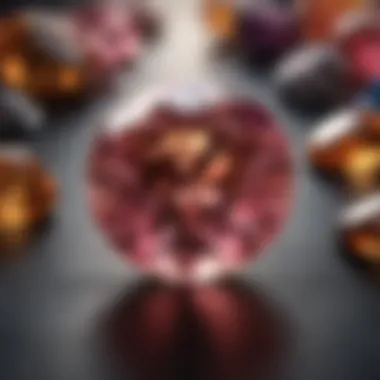
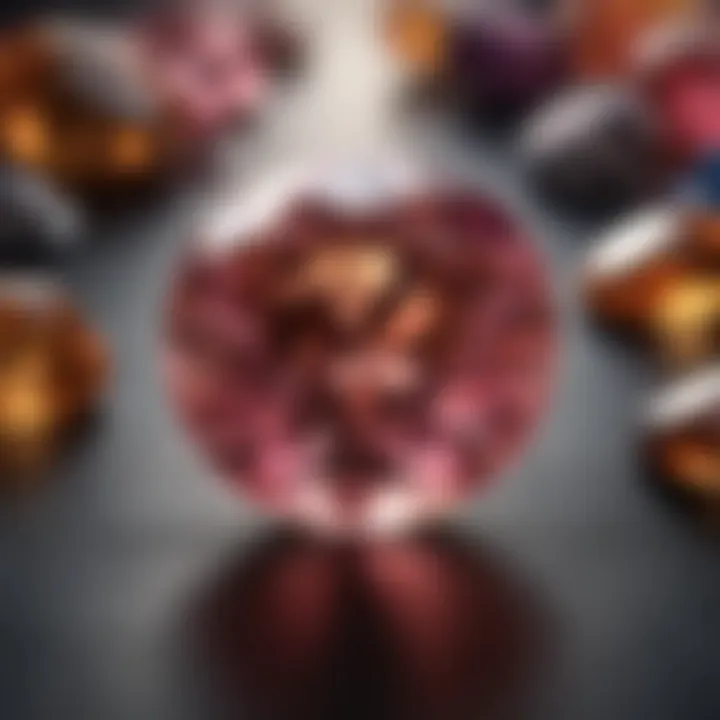
"Diamonds are more than a girl's best friend; they symbolize an unbreakable bond of loyalty and strength."
Understanding the metaphysical properties of diamonds enriches one's appreciation for these gems. Whether for emotional healing, spiritual growth, or symbolism of loyalty and resilience, diamonds hold a wealth of meaning that resonates deeply within many of us.
Cultural Significance of Diamonds
Diamonds hold an esteemed position within various cultures, serving as more than just decorative gemstones. Their cultural significance extends into realms of mythology, rituals, and social status. Understanding this cultural backdrop not only enriches one’s appreciation for diamonds but also sheds light on their role in human history and personal symbolisms. By examining diamonds through cultural lenses, we can grasp how their meanings evolve over time and across different societies.
Diamonds in Various Cultures
Indian Traditions
In India, diamonds are deeply rooted in tradition and spirituality. They are often linked with power and purity, mentioned in ancient texts such as the Vedas. The concept of wearing diamonds on auspicious days is prevalent, believed to bring good fortune. Additionally, diamonds are integral in bridal jewelry, showcasing the importance of marital ties in Indian culture. The key characteristic here is their connection to prosperity and love.
This deep-seated belief makes diamonds a beneficial choice for anyone seeking to explore their significance in an Indian context. They hold not just aesthetic value but also emotional resonance. A unique feature is their role in astrological practices. Certain gemstones, including diamonds, are recommended to enhance positive energies in one’s life based on astrological readings, reflecting their advantage as symbols of both tradition and personal guidance. However, one must tread carefully, as superstitions can sometimes lead to unrealistic expectations.
Western Modernity
In contrast, diamonds in Western cultures are predominantly viewed through the lens of romance and commitment. The tradition of diamond engagement rings, popularized in the early 20th century, symbolizes everlasting love and fidelity. The key aspect of this tradition is its emphasis on permanence, making diamonds synonymous with life’s pivotal moments.
This cultural framing is beneficial for understanding modern diamond use as symbols of relationship milestones. A unique feature of this Western view is the mass marketing of diamonds through memorable campaigns, reinforcing their association with luxury and love. However, the rise of alternative gemstones and ethical considerations regarding sourcing can sometimes complicate their desirability, highlighting potential drawbacks in the modern marketplace.
Diamonds in Folklore
Myths and Legends
Diamonds have woven themselves into the fabric of myths and legends throughout history. From ancient tales of divine favor to stories of invincibility, they embody human aspiration and spiritual beliefs. A key characteristic of these legends is their portrayal of diamonds as life-giving stones, believed to protect warriors and ensure prosperity.
Choosing to explore such myths offers readers benefits of understanding the historical weight and allure that diamonds carry. The unique feature that sets these legends apart is how they reflect human emotions—fear, desire, and hope—allowing diamonds to transcend their physical form. However, interpretations may vary widely, leading to misconceptions that are worth noting.
Popular Connotations
Popular culture further enriches diamonds’ reputations. From Hollywood’s glitzy red carpets to everyday celebrities, diamonds symbolize wealth and success. Their portrayal in films and music adds layers of meaning, turning them into markers of status and aspiration. This key characteristic makes diamonds not just fashion items but cultural icons.
Understanding these connotations is a valuable tool for anyone wishing to navigate modern jewelry culture. Diamonds represent aspirations that go beyond mere materialism, inviting reflection on the complexities of societal values. The unique aspect to consider is their decreasing exclusivity, with many people now seeking unique or lab-created alternatives. Hence, while they remain significant, the shifting landscape suggests that diamond connotations may evolve over time.
"The diamond may shine bright, but it's the stories and traditions that give it lasting value."
Selecting the Right Diamond
Selecting the right diamond is not just a matter of picking a shiny stone; it’s about making a choice that resonates with personal values, style, and financial considerations. Diamonds symbolize significant life events, whether it be engagements or anniversaries, and the right selection can elevate those moments. This section offers practical insights to make the task less daunting and more rewarding.
Factors to Consider
Budget Constraints
When it comes to budget constraints, one must tread carefully. Setting a budget can seem limiting, but in reality, it helps narrow down options. A key characteristic of budget constraints is that they push you to explore various diamond qualities without breaking the bank. Consideration here is essential, as diamonds can come with quite the price tag.
- Unique feature: Knowing your financial limits allows you to focus on diamonds that fit your parameters, whether it’s for a modest engagement ring or a lavish statement piece.
- Advantages: A clear budget cultivates patience, letting you take the time to find a diamond that not only visits your wallet but suits your taste.
- Disadvantages: Overshooting your budget can lead to feelings of regret if financial stress follows the purchase.
Personal Style
The interplay between a diamond’s design and one’s personal style is a dance that influences choice immensely. Reflecting this in your selection can lead to a more fulfilling purchase. Personal style highlights individual expression. Finding a diamond that matches your aesthetic can truly enhance the beauty of the piece.
- Unique feature: Whether vintage, modern, or bohemian, there’s a diamond for every taste. It’s not just about sparkle; consider cut, setting, and overall vibe.
- Advantages: A well-chosen diamond encapsulates one’s personality and makes the piece eternally cherished.
- Disadvantages: Trendy styles may fade, although classic cuts often remain timeless. This could lead to a clash between present-day vibes and future preference.
Engagement and Wedding Rings
Traditional Choices
In the realm of traditional choices, diamonds have long held a place of honor. From solitaires to halo settings, these designs support the historical significance of the diamond. The characteristic here is enduring value and established elegance.
- Unique feature: Traditional diamond engagement rings are often associated with durability and perpetual beauty, signifying lasting love.
- Advantages: These designs typically retain value over time, appealing to collectors and lovers of classic jewelry.
- Disadvantages: Some may find traditional patterns too conventional, with little room for individual expression in a world that increasingly celebrates uniqueness.
Modern Alternatives
As society evolves, so do diamond ring choices. Modern alternatives include unique cuts, colorful gemstones, and innovative settings that speak to today's aesthetic. The key characteristic of modern design is creativity and individuality.
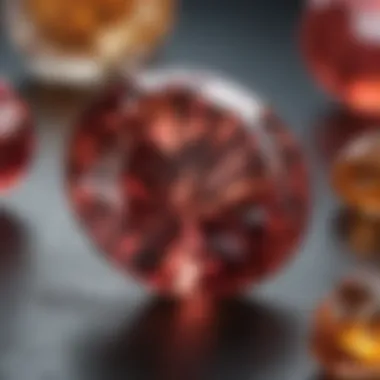
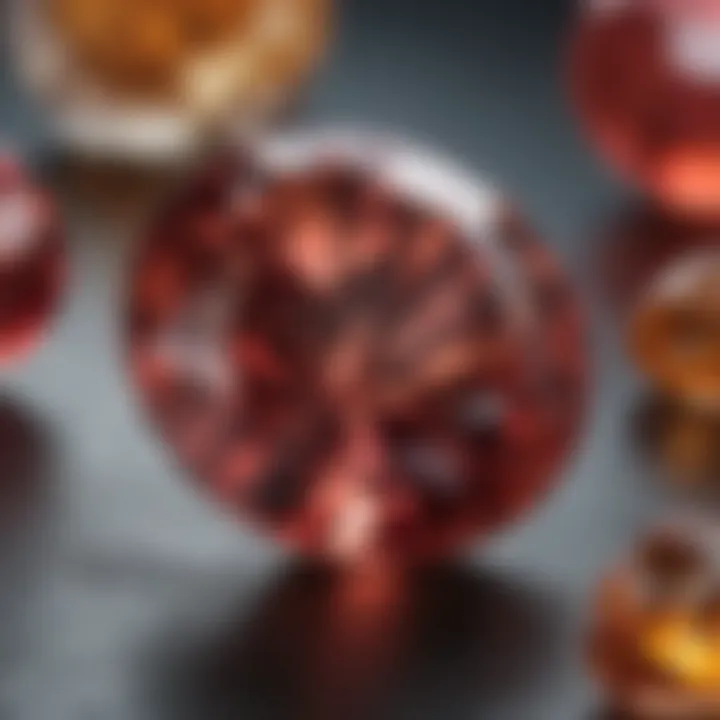
- Unique feature: Modern rings often allow for a more personalized narrative, inviting one to include custom engravings or even mix and match different gemstone styles.
- Advantages: These rings tend to stand out, making them a fantastic option for couples wanting something that reflects their personality.
- Disadvantages: Resale value may be variable; trends shift quickly, and what is in vogue today may fall out of favor tomorrow.
Choosing the right diamond can be a journey in self-discovery as much as it is a financial decision. An awareness of budget constraints and an alignment with one’s personal style play a pivotal role in that process. Traditional and modern choices offer a wide array of options that can satisfy both the heart and the wallet. The goal is to find a diamond that tells your story, one sparkle at a time.
Caring for Diamonds
Caring for diamonds is a fundamental aspect that often goes overlooked but is crucial for maintaining their sparkling allure. While diamonds are tough, not every diamond is created equally, and they can still accumulate dirt and scratches over time. Proper care not only keeps them looking pristine but also ensures their longevity, making them a cherished piece for years. Ignoring this responsibility can diminish their brilliance and lead to damage, which nobody wants, especially for such a coveted stone.
Cleaning Techniques
Keeping diamonds clean is essential for preserving their fire and brilliance. Here are a few practical cleaning techniques that are easy to follow:
- Warm Soapy Water: A gentle approach usually works best. Mix a few drops of mild dish soap in warm water. Soak your diamond jewelry for about 20-30 minutes, then use a soft brush to scrub the setting and remove any grime. Rinse with clean water and gently dry with a lint-free cloth.
- Ultrasonic Cleaners: These devices can be very effective, but caution is advised. Not all diamonds or settings will respond well to ultrasonic cleaning. If you have any doubts, consult a professional before using this method.
"Just like a good cup of coffee needs the right beans, a diamond needs the right care to shine its best."
- Professional Cleaning: Bringing your diamond to a jeweler every now and then for professional cleaning is a wise move. They have specialized tools and knowledge to clean and inspect your diamond properly.
Storage Recommendations
When it comes to storage, proper handling of diamonds can avoid scratches and chips, which can mar their surface and reduce their value. Here are some practical storage tips:
- Separate Storage: Always store diamonds separately from other jewelry to prevent any scratching. A soft pouch or a lined jewelry box can do wonders for keeping your diamonds safe.
- Avoid Impact: When there's a chance of impact, such as during travel or moving, ensure that your diamonds are securely packed to avoid any jostling around. A hard case with foam padding might be beneficial.
- Maintain Optimal Environment: Store diamonds in a cool and dry place, away from direct sunlight. Prolong exposure to heat can lead to tarnishing of the metal, which can indirectly affect the setting and appearance of the diamond.
The Future of Diamonds in Jewelry
As we look ahead at the world of jewelry, the role diamonds play is evolving in fascinating ways. No longer merely symbols of wealth and status, diamonds are now entering a stage of innovation fused with social consciousness. Understanding these shifts is essential for both consumers and industry insiders alike. This section aims to illuminate the future of diamonds in jewelry, exploring trends that are reshaping their presence, while also emphasizing ethical considerations crucial to this transformation.
Trends in Diamond Jewelry
In recent years, we’ve witnessed a significant change in the design and purpose of diamond jewelry. Here are some standout trends:
- Lab-grown Diamonds: They are gaining traction among eco-conscious consumers. Unlike natural diamonds, lab-grown options are often more affordable and possess identical physical and chemical properties. These stones present the same brilliance but involve processes that are more environmentally friendly.
- Minimalist Designs: There’s a growing preference for subtle elegance. Simple, delicate settings that enhance the diamond’s natural beauty are becoming all the rage. This trend emphasizes quality over quantity, moving away from ostentatious styles.
- Mixed Materials: Designers are increasingly blending diamonds with alternative materials, such as wood, ceramic, or recycled metals. This creative amalgamation allows for unique, bespoke pieces that align with modern aesthetics.
These trends indicate a shift from traditional diamond jewelry showcases, encouraging innovation while enhancing consumer experience.
Ethical Considerations
As the demand for sustainability continues to climb, consumers are more vigilant about diamond sourcing. Ethical considerations are now at the forefront of purchasing decisions, leading to profound impacts on the industry.
Sourcing Practices
The way diamonds are sourced says much about their future. Traditional mines often come under scrutiny for their environmental impacts and labor practices.
- Key Characteristic: Responsible sourcing practices ensure that diamonds are obtained ethically, minimizing harm to ecosystems and communities.
- A Beneficial Choice: Choosing ethically sourced diamonds not only reflects personal values but encourages brands to maintain social responsibility. Shoppers today are leaning towards sellers who provide transparency regarding their supply chains.
- Unique Feature: Some retailers have adopted blockchain technology to trace the origins of their diamonds. This digital record provides peace of mind, letting customers verify the ethical journey of their gemstones.
Sustainability Efforts
Sustainability is no longer just a buzzword; it's become a necessity within the diamond industry.
- Key Characteristic: The focus on sustainable practices enhances the longevity of resources and protects natural habitats affected by mining.
- A Popular Choice: Jewellers who prioritize sustainability often engage in community development projects. This alignment between commerce and community strengthens brand loyalty while making a positive impact.
- Unique Feature: Initiatives like "diamonds with a cause" not only promote responsibly sourced stones but also contribute a portion of sales to environmental or social causes. Such practices resonate with today’s consumers who want their purchases to reflect their values.
"An informed buyer is the best kind of buyer; they drive the market toward ethical innovation."
In summation, understanding the future of diamonds in jewelry encapsulates a broad spectrum of trends and ethical considerations. As technology advances and awareness grows, consumers are empowered to choose diamonds that resonate with their ideals and lifestyles, shaping a more responsible diamond industry.
Finale
The conclusion of this exploration delves into the essence of what diamonds represent as the birthstone for those born in April. This vibrant gemstone carries not only a visual brilliance but also a depth of meaning that resonates with many. The ongoing popularity of diamonds can be attributed to their enduring qualities, both physical and symbolic, which uphold their status as a cherished choice for life’s significant moments.
The Enduring Allure of Diamonds
Diamonds have an unmatched appeal that transcends generations. Their clarity and rare beauty make them symbols of status and commitment. Historically, these gemstones have adorned the crowns of royalty and adorned significant milestones like engagements and weddings. Their strength is not just in their physical durability—they rank the hardest mineral, after all—but in their representation of unbreakable bonds and everlasting love.
"A diamond is forever" is not merely a catchy slogan; it reflects a deeper truth about how people perceive this gemstone. The purity and resilience signify a love that withstands the tests of time.
Moreover, the emotional connections tied to diamonds often come from personal stories and family traditions. Many individuals pass down pieces as heirlooms, each holding its unique narrative within the family. In this way, diamonds continue to sparkle through individual histories, nurturing attachments that make them cherished objects.
Final Thoughts on April Birthstone
As we wrap up this comprehensive look at the birthstone for April, it becomes apparent that diamonds are much more than mere gemstones. They encompass a rich tapestry of cultural significance and personal importance. Understanding their various attributes—whether it’s clarity, color, or the unique stories behind them—allows one to appreciate the deeper meanings that come with owning or gifting a diamond.
For those who identify with the April birthstone, the diamond symbolizes not just who they are, but what they aspire to be: strong, resilient, and connected to those they love. From the choices made in selecting the perfect diamond for an engagement ring to its role in personal expression, it is clear that this gem holds a special place in both history and modern culture.
Whether seen in the glimmer of jewelry or felt through generations of familial bonds, the allure of the diamond continues to shine bright, inviting both admiration and reflection.



